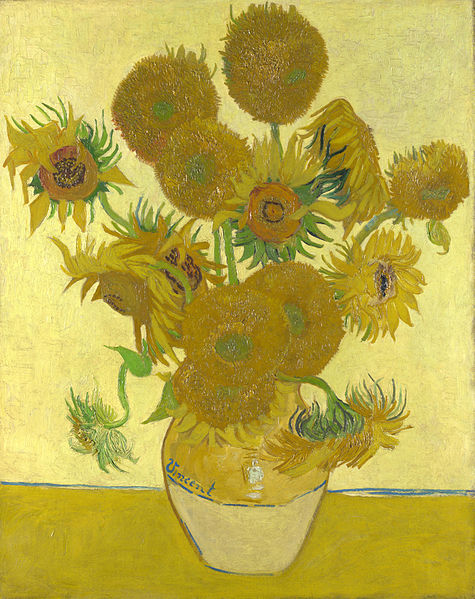Artwork Preservation and Restoration in the News
Although I usually write about art from the perspective of an artist or a viewer, there is a lot to be learned from looking at art from the perspective of an archivist. While looking through the “news roundup” feature on Arrested Motion, I saw a couple of very interesting stories related to archival concerns.
First up, from the Independent – it would appear that LED light is damaging Van Gogh’s sunflower paintings.
Scientists have discovered that the bright-yellow pigment featured in several famous artworks becomes unstable under LED lights and, over time, turns a shade of brownish green. A sample of 14 works from the period between 1887 and 1890 were tested for the reaction which affects the oil paint colour known as chrome yellow. It was favoured by 19th-century artists and has been found in important works by Paul Cézanne and Paul Gauguin. …LED lighting has become an increasingly popular choice with art institutions in recent years as an energy-efficient alternative to fluorescent light bulbs. It was also thought to provide better protection for pictures by avoiding the harm caused by the effects of natural light and other forms of illumination.
But a series of experiments provoked by art curators’ growing fears that a number of their masterpieces were darkening in colour has suggested that some types of LED lights may be to blame for the damage.
Basically the pigment lead chromate that was used to make chrome yellow, a popular choice in the late 19th century turns out to be more unstable than was previously thought. Consider this badly discoloured 1888 painting owned by the National Gallery in London, England…
…and now take a look at this painting, also from 1888, owned by Neue Pinakothek in Munich.
This is not the first of Van Gogh’s works to undergo radical colour transformation. Many of his paintings used a vivid pink, Geranium Lake, that has since faded to a light grey. The Van Gogh Museum discusses restoring these works in some detail.
In more recent art news, when Hurricane Sandy pummeled New York this past October, huge amounts of damage were caused to the low-lying areas of Manhattan, including the Chelsea district – which happens to also be home to many of Manhattan’s galleries. Printed Matter, a West Chelsea non-profit art bookstore was one of them. Here’s a snippet from a very interesting interview from npr.org.
KALISH: When Senior learned that Printed Matter’s archive was under water after the hurricane, he rode his bicycle into Manhattan from Queens and helped clean out the store’s basement. He was part of a small army of volunteers in the days following Sandy that boxed up what might be salvaged.
Twenty of those boxes are now with a disaster restoration company called Polygon. First, they were frozen, then sent to the Boston area and placed inside a vacuum freeze dried chamber. Summer Street is with Polygon’s document recovery division.
SUMMER STREET: We put in the frozen materials. And once we close the chamber, we have a vacuum pump that actually brings down the atmospheric pressure. And in that process, the solid water will actually skip the wet phase and turn right into a vapor. It would not be something anyone would ever want to experience.
KALISH: Street says that because Printed Matter’s archive was frozen so soon after being soaked, it has an excellent chance of being salvaged. This is costing thousands of dollars, but a couple of foundations have awarded grants for the archive restoration. The bookstore is now faced with finding an alternative to its basement for storage. Not easy in the gentrified Chelsea neighborhood, says Printed Matter’s James Jenkin.
It’s pretty amazing that this kind of restoration process exists. Some days I feel like I’m in a science fiction novel. If you would like to read more about Hurricane Sandy’s impact on the art world, I recommend this article from the New York Times.




